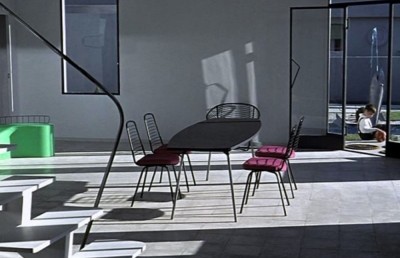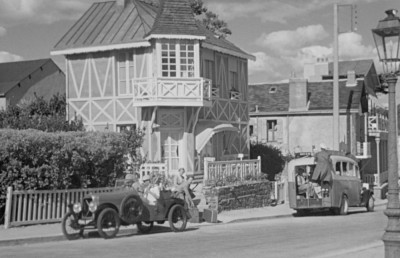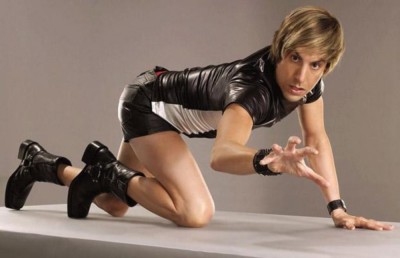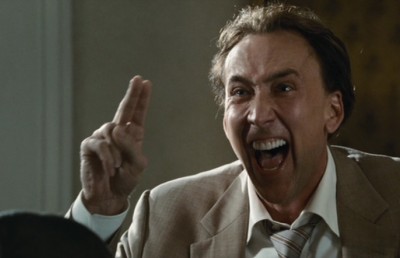Mon Oncle: Tati, Bergson and Cinematic Comedy
_1000_420_90_c1.jpg)
“A Tati film is an odd combination of silent and sound film, of old-style sight gags in contemporary settings […] Tati is able, more successfully than any contemporary comedy filmmaker, to construct his own filmic universe using a delicate balance between comic situations, sound effects, characterizations, settings, screen size and pacing.” [1]
Any discussion pertaining to the comic, owes its readers the privilege of knowing to what extent its arguments consider matters comic. For while rarely regarded as complex by the general public, comedy is steeped in a discourse whose breadth equals that of any creative articulation. The mysteries of laughter and the comic have titillated philosophers for centuries: Plato, Aristotle, Hobbes and Kant have all left their mark on the elusive subject. And though this essay is solely concerned with film comedy, philosophies preceding cinema will also benefit this analysis. Namely Henri Bergson’s writing on the topic, Laughter: An Essay on the Meaning of the Comic, first published in 1900, during the infancy of cinema. Beyond this, philosophers of old will be delegated the honour of being influential, and of developing the foundation for which recent theoreticians continue to build upon.
To explore the intersection of comic philosophy and film comedy I will analyze a singular auteur, Jacques Tati, specifically his third feature length film Mon Oncle (1958). Of course the plurality of comic genius that pervades this work extends far beyond the constraints of any singular comedic philosophy. “Crowds and masses dominate Tati’s films,” notes Brent Maddock. [2] With this in mind I posit that Tati’s comic world operates on the principle of the microcosm, which is a by-product of what many have expressed as his “democratic” filmmaking style. The democracy of Tati’s image can be likened to “Bazin’s notion of a ‘democratic’ mise-en-scène that allows the viewer freedom to scan the image” (the use of the long take, moving camera, depth of field, etc.) [3] My aim is to look at Mon Oncle as a microcosm and describe the degree and variety of comedy this film exhibit both philosophically and aesthetically.
The microcosm of Mon Oncle is a multifaceted one. Brent Maddock has remarked, “Tati’s move to identify Hulot with a community can be seen as an attempt to make Hulot represent more than simply himself.” [4] The following example not only illustrates the social microcosm of Tati’s universe, but also the aesthetic one. The scene in question begins with an extreme long shot of Hulot’s apartment building. However, it is not the frontal framing that first presents the building to us, but a framing from an angle that attributes more emphasis to the street below. Two kids are playing in the middle of the street. As they walk towards the camera, pulling and pushing at one another, three more kids enter the frame from off screen. They emerge from around the far corner of Hulot’s building, screen right, and suddenly all the children begin to run towards the camera, now aware of each other’s presence. They exit screen left and the camera cuts to a low angle long shot of Hulot’s balcony and front door. On the cut Hulot emerges from his apartment and walks over to his clothe line which is screen right. Pulling two towels off the line, he then turns around to walk away slinging one of them over his shoulder. Although he is unaware of the ensuing mishap the audience sees that while slinging the towel over his shoulder Hulot actually places it back on the clothes line. A few steps later, towards screen left, Hulot realizes that the towel is not where he had placed it. Of course he is too absentminded to consider that it may be on the line, so he stumbles around looking everywhere but there. As his eyes glance down towards the street below the camera cuts, as if to adopt his point of view, to a medium long shot of a vendor’s carriage filled with lettuce and other greens.
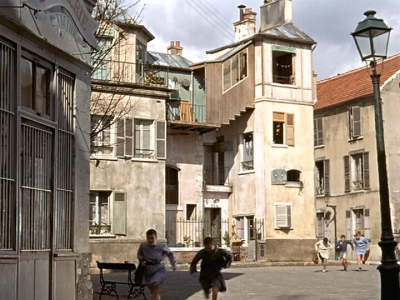
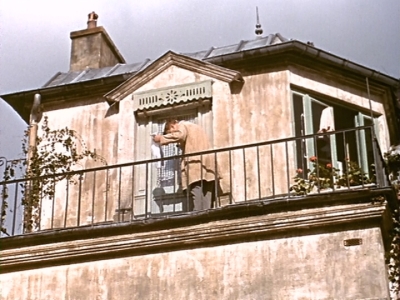
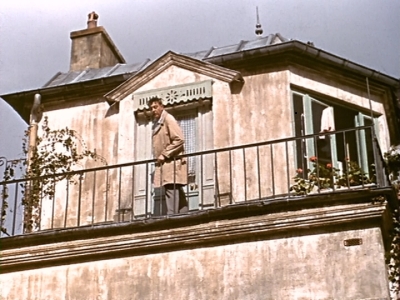
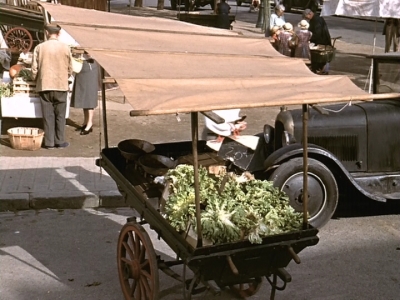
Behind the carriage a lady is walking towards screen right, and the camera cuts as she exits the frame. The following shot is a medium two shot of the lady and the Italian vegetable vendor. She asks for grapefruit and he complies but not without mumbling some incoherent complaints to himself. He then weighs the fruit and asks for what is apparently an absurd amount of money. A third man then enters the frame and notices that the scale is not properly set. The camera tracks back, and slightly to the left ending in a medium long shot, as the man discovers that a flat tire on the vendor’s truck is causing the calibration of the scale to be askew. The vendor then makes his way to the driver side and as he opens the door a flood of tools falls out onto the pavement (which is somewhat of a running gag, as it occurs again when he delivers an order to the Arpel’s). He seems unmoved by this and retrieves a pump to inflate the tire. In less than two minutes of screen time Tati presents the beginnings of several mishaps, all perpetuated by different characters. The multiplicity of events, and their resemblance to the mishaps normally associated with Hulot, clearly illustrates Maddock’s claim that Hulot is being made to represent more than just himself (a microcosm).
A closer look at the gags themselves reveals that the microcosm is one that also explores a multiplicity of comic theories. Henri Bergson’s claim that absentmindedness is a staple of comedy is undoubtedly the driving force behind Hulot’s character, and is perfectly exemplified in his struggle to find the missing towel. However, for Bergson there is more to absentmindedness than simply being in a state of unconsciousness: “[…] it is really a kind of automatism that makes us laugh— an automatism, as we have already remarked, closely akin to mere absentmindedness.” [5] There is also the presence of what Noël Carroll calls the “mutual interference” gag, in which “the character’s view of a situation diverges from the reality of the situation.” [6] Although Carroll describes this gag as typically playing upon the perspective of a second or third character, the interplay that exists between Carroll’s sight gag and Bergson’s theory of automatism, or what he eventually refers to as “the mechanical encrusted upon the living,” places Hulot in a comic situation that implements himself as both victim and practical joker. These theories are then carried over to the following shots, thus extending Hulot’s automatism to the community where he lives. In doing so, Arthur Koestler’s theory of biosociation (outlined in Totaro’s essay in this issue) is thus implied. To fully describe Koestler’s theory in relation to Mon Oncle would require an extensive deliberation of the many recurring gags, such as the fruit vendor’s dilemma with tools falling out of his front seat. This stems from the dichotomy that the film sets up between the Arpel’s modern world and Hulot’s world of tradition.
According to Lee Hilliker, “in Mon Oncle, the sense of true free time, of re-creation, is associated with older, more rural areas, although it makes an appearance in the new house and workplace as well.” [7] Koestler’s theory of biosociation (a creative process whereby the mind thinks across two normally incompatible planes of thought, what’s sometimes called ‘lateral thinking’ or what Koestler simply calls, ‘two plane thinking’) is the result of a few minor gags, such as the whale book that Gerard has manipulated to spout water from its blowhole—hence the biosociation is a result of the connection that is drawn from Gerard’s fish to the water spouting fish sculpture in the Arpel home front yard, and perhaps even the store bought fish hanging out of Hulot’s bag that gets into a snarl down with a dog — yet the most emphatic example of biosociation is related to Hilliker’s observation that time is used extensively to point out contrasts, and similarities, between modernity and tradition. Consider the representation of time in the above-mentioned scene. To say that it is purely recreational in nature is a slight oversight on Hilliker’s part, for the people portrayed are in fact working. The citizens of the old quarter are placed in situations that blur the line between recreation and work. As James Harding states, “uncle Hulot has the gift of showing [Gerard] how the apparently monotonous routine of daily life is in reality full of excitement and interest.” [8] Likewise, as spectators we observe this fact in the guise of aesthetics. The most dramatic instance of biosociation, or the instance that produces the most striking moment of epiphany, is the dinner party scene. I opt to refer to Tati’s biosociative moments as resulting in epiphanies rather than differentiating, as Koestler does, between “ha-ha” (the world of comedy), “aha” (the world of science), or “ah…” (the world of art) moments, because Mon Oncle is an amalgam of the various contexts to which these different expressions are related. Tati’s films, funny though they are, speak too many truths to be denied their sociological significance. One could even argue that the microcosm of his films, and the distanciation to which they adhere, is of a valid ethnographic perspective; “Tati’s less transcendent goal […] requires the blending assumption of a whole neighbourhood of ritual and activity: He is dependent upon an immediate recognition in socially definable terms.” [9]
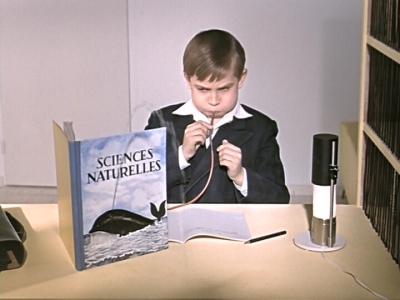
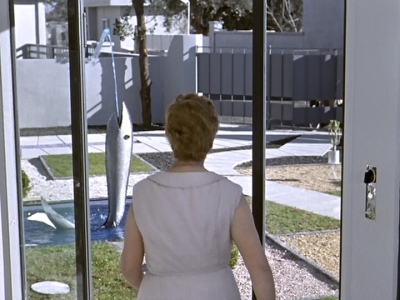
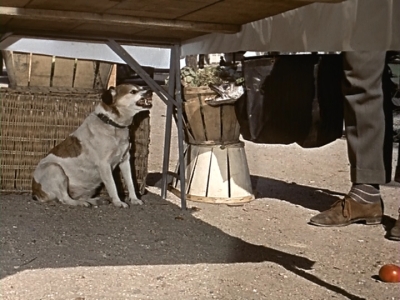
To further describe the way in which Tati’s representation of time draws associations between the two opposing worlds depicted in Mon Oncle, an extract from the dinner scene will be dissected. The scene is dense and lengthy, so the moment where Hulot is introduced to the Arpel’s neighbour is a good place to begin. Beginning from a medium long, two shot of Hulot and the single female neighbour: Hulot tells a joke, in pantomime, which does not register well with his new acquaintance. In turn she responds by puffing on her cigarette. She exhales, to hyperbolic excess, a stream of smoke that far surpasses any logical lung capacity. Hulot seems baffled by this and regularly looks down at his pipe in hand. Apart from the element of surprise, the comic aspect of this gag also benefits from what Carroll calls the “mimed metaphor” gag. This is a gag, “in which the audience [comes] to see an object metaphorically equated with something that it [is] not.” [10] The metaphor here is partially abstract: the cigarette, in contrast to Hulot’s pipe, is made to represent a certain aspect of time that is perpetuated by modernity. Indeed a pipe is different from a cigarette in that it cannot be made to represent a consistent and finite portion of time; a cigarette once smoked exists no longer. Hulot’s pipe, rarely lit to begin with, is not marked by such finitude, and his expression seems to support this premise. The camera then cuts away from the relatively tight two shot to a framing that places the Arpel’s ornamental fish in the neighbour’s approximate position of the previous frame. This graphic match suggests that Tati thinks a fish of the neighbour. Like the fish, or those who operate it, her opinion of whom or what is worthy of attention relies too much on social status and political correctness. [11] Likewise, the stream of water from the fish’s mouth recalls the jet of smoke she exhales.
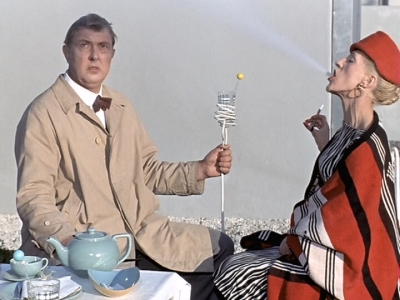
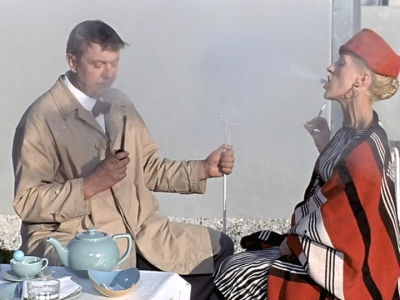
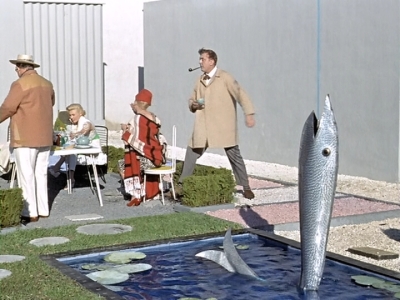
Hulot then stands up and looks for a place to insert the awkward cup holder he has been given. A few steps screen right and he lands it right into the piping that feeds the fish. The result is that chaos ensues and the scene becomes laden with representations of time that are more akin to Hulot’s old quarter than the Arpel’s modern home. Hulot’s action also results in another of Carroll’s mutual interference gags. Three shots later the camera crosses the axis and we now see Hulot making his way towards the door to turn the fish off. By now the seating area is wet so the guests decide to move the chairs and table. Of course the water is turned off, and without realizing it they place themselves around the hole that Hulot has made in the pipe. Meanwhile Madame Arpel is returning from the kitchen with refreshments. Upon noticing that the fish is not spouting water she frantically turns it back on. Hence the water is ejected high into the air, in the centre of the circle that has been formed by the guests. The gags in this scene are plentiful and multifaceted, so it will suffice to say that this prompts M. Arpel’s boss to fix the pipe. As a result, Tati is able to represent work in the context of the modern world, but with the playfulness that was previously only allotted to scenes occurring in the old quarter. The frame adopts a kineticism that was previously a privileged motif of the old quarter. Furthermore, the destruction implemented by Hulot leaves the Arpel’s and their guests little choice but to assimilate to the sense of “free time” of which Hilliker writes.
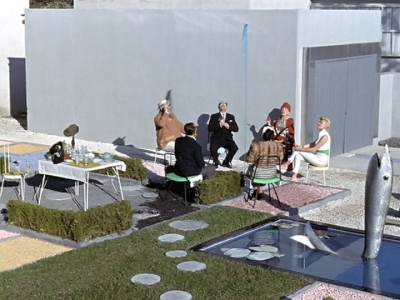
The comedy of Jacques Tati does not conform to any one comic philosophy (Bergson, silent comedy, comedy of observation, mild social satire). It builds itself up like a snowball tumbling down a mountain; perhaps inadvertently, but that is of little importance. The intellectual nature of Tati’s cinema cannot evade the inevitable epiphanies they elicit in each viewer. As Brent Maddock has said, “Tati’s films speak to everyone because they concern themselves with the very systems of behaviour and patterns of living of contemporary man.” [12] To this I would add that his comedy is the result of making obvious the absurdity of these patterns and behaviours, by placing them in situations that call for something entirely different. This is quite similar to Bergson’s theory of “the mechanical encrusted upon the living,” for this world in which we live is becoming increasingly mechanized, and as of yet this mechanization has not been mastered by its creators. This is what Tati’s films are about, and by way of Hulot we can be mediated in such a way that our future, and the way that technology is headed seems less tragic. That is a beautiful thing –and a very funny thing.
Endnotes
1 Maddock, p. 3.
2 Maddock, Brent. (1977). The Films of Jacques Tati. Metuchen, N.J.: Scarecrow Press. p. 124.
3 Totaro, Donato. “Mon Oncle on DVD.” (2001): Offscreen. Web. 17 Nov. 2009.
4 Maddock, p. 64.
5 Bergson, Henri. 1900 “Laughter” in Comedy. Ed. W. Sypher (New York: Doubleday Anchor Books, 1956), 71
6 Carroll, p. 30.
7 Hilliker 324
8 Harding, James. (1984). Jacques Tati: Frame by Frame. London: Secker & Warburg. p. 96.
9 Simon, John K., “Hulot, or, The Common Man as Observer and Critic.” Yale French Studies Humor.23 (1959): 18-25. JSTOR. Web. 17 Nov. 2009. p. 23.
10 Carroll, p. 3.
11 Harding, p. 97.
12 Maddock, p. 6
Bibliography
Bergson, Henri. 1900 “Laughter” in Comedy. Ed. W. Sypher (New York: Doubleday Anchor Books, 1956), 61-85.
Carroll, Noel. “Notes on the Sight Gag.” Comedy/Cinema/Theory (Berkley and Los Angeles, California: University of California Press, 1991), 25-42.
Harding, James. (1984). Jacques Tati: Frame by Frame. London: Secker & Warburg.
Hilliker, Lee. “In the Modernist Mirror: Jacques Tati and the Parisian Landscape.” The French Review 76.2 (2002): 318-329. JSTOR. Web. 16 Nov. 2009.
Horton, Andrew. “Introduction.” Comedy/Cinema/Theory (Berkeley and Los Angeles, California: University of California Press, 1991), 1-19.
Koestler, Arthur. “Humour and Wit.” Janus: A Summing Up. London: Pan Books, 1978, 109-130.
Maddock, Brent. (1977). The Films of Jacques Tati. Metuchen, N.J.: Scarecrow Press.
Schein, Harry. “What Is Film Humor?” The Quarterly of Film Radio and Television 11.1 (1956): 24-32. JSTOR. Web. 15 Nov. 2009.
Simon, John K. “Hulot, or, The Common Man as Observer and Critic.” Yale French Studies Humor.23 (1959): 18-25. JSTOR. Web. 17 Nov. 2009.
Totaro, Donato. “Mon Oncle on DVD.” (2001): Offscreen. Web. 17 Nov. 2009.


